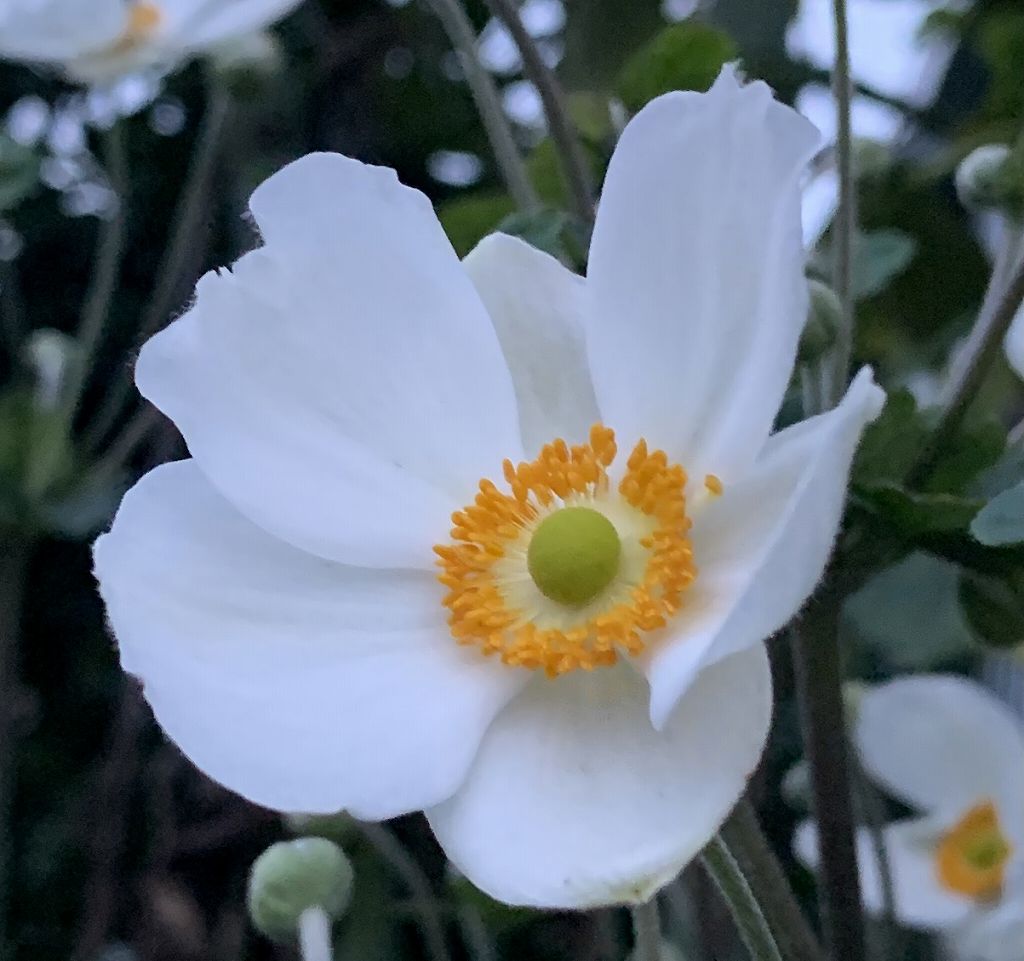シュウメイギクが風に揺れる姿は楚々として儚げ。秋の風情があって優雅な花です。花びらのように見えるのは萼片。花弁は退化しています。
The appearance of the Japanese anemone swaying in the wind is fragile and ephemeral. It is an elegant flower with an autumn atmosphere. It is the calyx that looks like a petal. The petals are degenerated.
【仮名】シュウメイギク, キブネギク
【和名】秋明菊, 貴船菊
【英名】Japanese Anemone, Japanese Thimbleweed
【学名】Anemone hupehensis
【誕生】09/ 14, 09/ 30, 10/ 08, 10/ 15
【開花】08, 09, 10, 11月
【花色】White, Pink, Purple



シュウメイギク
シュウメイギクの来歴
シュウメイギクは、キンポウゲ科の多年草です。名前に「キク」が付くものの、「アネモネ」の仲間。英名や学名に「日本」が付くものの、原産地は中国です。日本では古くに京都の貴船地方で野生化し、原種の「キブネギク」に。今は改良種も含めてシュウメイギクと総称されます。
シュウメイギクの自生
シュウメイギクが野山に自生し、風に揺れる姿は楚々として儚げ。花壇や鉢植えに広く利用され、切り花としても好まれます。秋の風情があって優雅な花なので、華道の素材や茶花としても重用。花言葉は「薄れゆく愛情」「淡い思い」「あせていく愛」「多感なとき」「忍耐」です。
シュウメイギクの形態
シュウメイギクの花は、茎の先端に1輪、その両脇に1輪ずつ、その両脇に…と、順に花を咲かせます。葉は3裂で互生。地下茎は太く長く伸びて根を張り、いたるところから不定芽を出します。茎葉は毒性のあるプロトアネモニンを含み、乳液に触れると皮膚がかぶれるので要注意。
シュウメイギクの花
シュウメイギクの一重咲きの花は、花びらのような5枚が萼片で、花弁は退化しています。八重咲きも萼片と雄しべが変化したもの。花の色と形は原種が赤紫色の八重咲き、改良種が桃色や白色の一重咲きです。花の中央は黄色で雄しべが密集。花後は綿毛に包まれた種子が実ります。
シュウメイギクの品種
シュウメイギクの品種は多様。桃花では八重咲きの「貴船菊」が原種本来の紅色で花を平らに咲かせます。一重咲きだと「ダイアナ」が人気。白花では一重咲きの「台湾秋明菊」が草丈も高く、山野草のようです。矮性種では欧州で改良された「チャボ」。コンテナでも栽培できます。
Japanese Anemone
Provenance of Japanese anemone
Japanese anemone is a perennial plant of the Ranunculaceae family. Although “Kiku” is attached to the name, it is a member of “Anemone”. Although “Japan” is added to the English name and scientific name, the place of origin is China. In Japan, it became wild in the Kibune region of Kyoto for a long time and became the original species “Kibunegiku”. Now it is collectively called Japanese anemone including improved species.
Japanese anemone native
The appearance of Japanese anemone growing naturally in fields and swaying in the wind is fragile and ephemeral. Widely used for flower beds and potted plants, it is also preferred as a cut flower. Since it is an elegant flower with an autumn atmosphere, it is also important as a material for flower arrangement and tea flowers. The flower language is “fading love,” “pale thoughts,” “fading love,” “sensitive times,” and “patience.”
Japanese anemone morphology
The flowers of Japanese anemone bloom in order, one on the tip of the stem, one on each side, and one on both sides. The leaves are 3 fissures and alternate. The rhizome grows thick and long, roots, and sprouts adventitious buds everywhere. Be careful as the foliage contains toxic protoanemonin and the skin may get irritated when it comes in contact with the emulsion.
Japanese anemone flower
The single-flowered flower of Japanese anemone has five petal-like sepals, and the petals are degenerated. Double-flowered flowers have changed calyxes and stamens. As for the color and shape of the flower, the original species is red-purple double-flowered, and the improved species is pink or white single-flowered. The center of the flower is yellow and the stamens are dense. After flowering, seeds wrapped in fluff will grow.
Japanese anemone varieties
There are various varieties of Japanese anemone. In pink blossoms, the double-flowered “Kibunegiku” blooms flat with the original crimson color of the original species. “Diana” is popular when it is a single bloom. Among the white flowers, the single-flowered “Taiwan Shumeigiku” has a high plant height and looks like a wild grass. In the dwarf species, “Chabo” improved in Europe. It can also be cultivated in a container.


